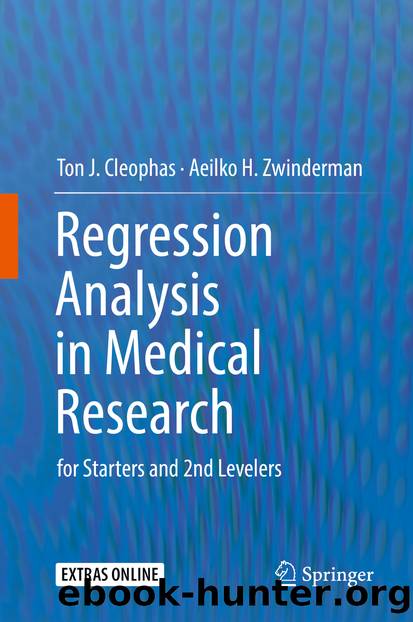Regression Analysis in Medical Research by Ton J. Cleophas & Aeilko H. Zwinderman

Author:Ton J. Cleophas & Aeilko H. Zwinderman
Language: eng
Format: epub
Publisher: Springer International Publishing, Cham
13.3 Canonical Regression
Like Manova, canonical analysis is based on multiple linear regression, used to find the best fit correlation coefficients for your data. However, because it works with Wilks’statistic and beta distributions rather than Pillai’s statistic and normal distributions, it is able to more easily calculate overall correlation coefficients between sets of variables. Yet, it also assesses, how a set of variables, as a whole is related to separate variables. Along this way, an overall canonical model can be further improved by removing unimportant variables. Canonical analysis may be arithmetically equivalent to factor-analysis/partial least squares analysis, but, conceptionally, it is very different. Unlike the latter, the former method does not produce new (latent) variables, but rather makes use of two sets of manifest variables. Also, unlike the latter, it complies with all of the requirements of traditional linear regression, and is, therefore, scientifically rigorous. A canonical analysis should start with a correlation matrix. Variables with large correlation coefficients must be removed from the model. If in canonical models the clusters of predictor and outcome variables have a significant relationship, then this finding can, just like with linear regression, be used for making predictions about individual patients. We will again use SPSS statistical software. The Menu does not offer canonical analysis, but the Syntax program does. Canonical analysis should start with a collinearity matrix. This is because the uncertainty of the canonical weights, being the main outcome of a canonical regression, are severely overestimated in case of collinearity. Variable versus variable correlation coefficients larger than 0.80 means that the models is collinear and that the collinear variables should be removed from the model. In order to assess collinearity, a correlation matrix must be first constructed. We will use the data example from the previous section once more.
Command:
click File… .click New… .click Syntax… .the Syntax Editor dialog box is displayed… .enter the following text: “correlations/variables = “and subsequently enter all of the gene-names… .click Run.
Download
This site does not store any files on its server. We only index and link to content provided by other sites. Please contact the content providers to delete copyright contents if any and email us, we'll remove relevant links or contents immediately.
| Anatomy | Animals |
| Bacteriology | Biochemistry |
| Bioelectricity | Bioinformatics |
| Biology | Biophysics |
| Biotechnology | Botany |
| Ecology | Genetics |
| Paleontology | Plants |
| Taxonomic Classification | Zoology |
Sapiens: A Brief History of Humankind by Yuval Noah Harari(14252)
The Tidewater Tales by John Barth(12608)
Mastermind: How to Think Like Sherlock Holmes by Maria Konnikova(7227)
Do No Harm Stories of Life, Death and Brain Surgery by Henry Marsh(6891)
The Thirst by Nesbo Jo(6826)
Why We Sleep: Unlocking the Power of Sleep and Dreams by Matthew Walker(6618)
Life 3.0: Being Human in the Age of Artificial Intelligence by Tegmark Max(5474)
Sapiens by Yuval Noah Harari(5294)
The Longevity Diet by Valter Longo(5019)
The Body: A Guide for Occupants by Bill Bryson(4974)
The Rules Do Not Apply by Ariel Levy(4861)
The Immortal Life of Henrietta Lacks by Rebecca Skloot(4525)
Animal Frequency by Melissa Alvarez(4395)
Why We Sleep by Matthew Walker(4360)
The Hacking of the American Mind by Robert H. Lustig(4318)
Yoga Anatomy by Kaminoff Leslie(4306)
All Creatures Great and Small by James Herriot(4232)
Double Down (Diary of a Wimpy Kid Book 11) by Jeff Kinney(4207)
Barron's AP Biology by Goldberg M.S. Deborah T(4097)
